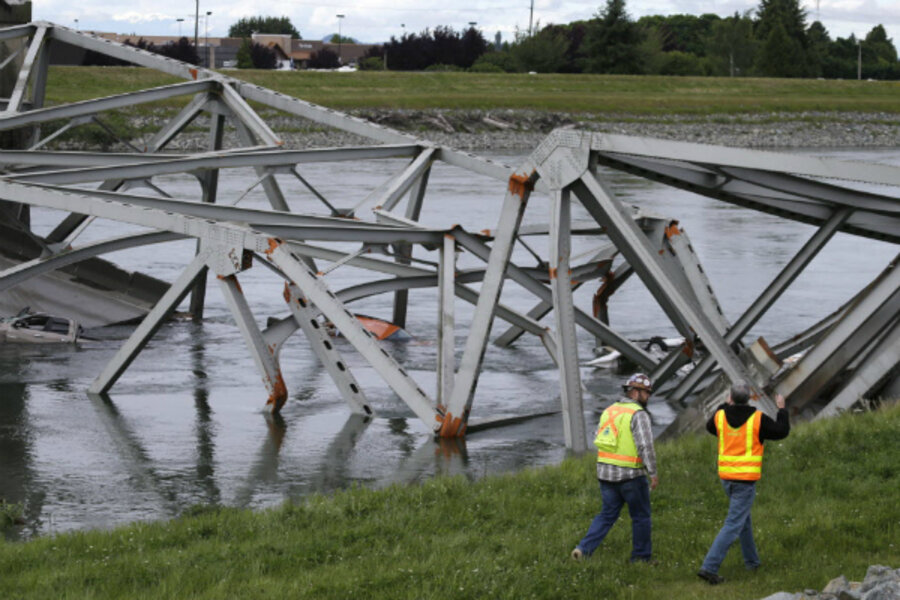Collapse of I-5 bridge in Washington State: no fatalities, many questions
Loading...
Three people were rescued from icy water after a section of the Interstate 5 bridge collapsed Thursday evening 60 miles north of Seattle, raising the prospect of a renewed debate over funding critical infrastructure repairs across the country.
A semitruck with an oversize load that hit the upper span of the bridge at about 7 p.m., Pacific time, caused the collapse, Washington State Patrol Chief John Batiste said during an overnight news conference. The truck made it off the bridge, and the driver remained at the scene and cooperated with investigators.
The local Skagit County Sheriff’s Department said two men and one woman were rescued from the water and transported to area hospitals, where they were all reported in stable condition, according to King 5 News in Seattle. State authorities say there were no fatalities.
“You talk miracles,” said Dan Sligh, one of the survivors, in an interview with the Seattle Times. “I don’t know what you want to call it. When you’re sitting down in the water and all that mangled metal of the bridge. You look around and you pinch yourself.”
The bridge, built in 1955, was inspected twice last year and repairs were made, according to state Transportation Secretary Lynn Peterson. The Los Angeles Times reports that the latest inspection was in November.
"It's an older bridge that needs a lot of work, just like a good number of bridges around the state," Ms. Peterson said.
Transportation officials are working on plans for either a temporary or permanent replacement, she said, and the National Transportation Safety Board is sending an investigative team.
The bridge was not classified as structurally deficient, but a Federal Highway Administration database listed it as being "functionally obsolete" – a category meaning that the design is outdated, such as having narrow shoulders and low clearance underneath.
The bridge is also classified as "fracture critical" by the National Bridge Inventory. That means the bridge is designed so that a failure in any one part of the bridge can collapse the entire span. There are some 18,000 fracture-critical bridges nationwide, of which 8,000 are also "structurally deficient," according to a 2012 review of Federal Highway Administration records by Bloomberg News.
The bridge has a sufficiency rating of 57.4 out of 100, according to federal records. That is well below the statewide average rating of 80, according to an Associated Press analysis of federal data, but 759 bridges in Washington have a lower sufficiency score.
The Seattle Times reported that, on average, about 70,000 vehicles use the bridge each day, 12 percent of them trucks.
Officials say the bridge, part of the major north-south highway connecting Seattle to Canada, will not be fixed for at least a few weeks, and they urged travelers to avoid the area over Memorial Day weekend.
The collapse of a portion of the I-35 bridge in Minnesota in 2007 killed 13 and injured 145, sparking a national reexamination of the safety of the country’s roads and bridges, many of which were built in the 1950s and 1960s.
More than 200 million trips are taken daily across structurally deficient bridges in the nation's 102 largest metropolitan regions, according to the American Society of Civil Engineers. In total, 1 in 9 of America's bridges is rated as structurally deficient, and the Federal Highway Administration estimates that it will take $76 billion – that is, $8 billion a year more than is currently being spent – to address the problem. The average age of the nation’s 607,380 bridges is 42 years.
Popular Mechanics writes that after the Minnesota bridge collapse, the state swiftly moved to build a new bridge, opening it 13 months later, three months ahead of schedule. The new bridge included embedded sensors to relay safety information to researchers at the University of Minnesota.
The Minnesota Department of Transportation also committed to replace or rehabilitate 120 of the state’s 172 structurally deficient and/or fracture-critical bridges by 2018.
President Obama’s budget proposal for 2014 calls for $21 billion to fund improvements and construction of new infrastructure. In March, he told a Miami audience: "We've still got too many roads that are in disrepair, too many bridges that aren't safe" and urged Congress to fund his proposal.
In 2009, $28 billion for bridge and highway repair were included in the $787 billion federal stimulus measure passed by Congress.
– Material from the Associated Press was used in this report.








